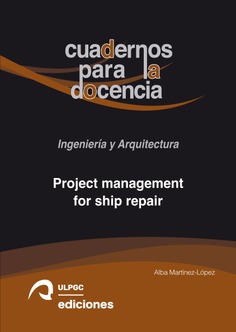
Project management for ship repair
Alba Martínez-López (Escritora)
La dirección de proyectos aplicada al naval constituye uno de los grandes desafíos de la ingeniería debido a la complejidad tecnológica de los buques, su envergadura y las exigentes limitaciones temporales para la ejecución obra. Este desafío es aún mayor en la reparación naval, donde las posibles averías no sólo maximizan la singularidad de la obra, sino que tensan sus márgenes temporales. Este cuaderno aborda específicamente la aplicación de la Dirección de Proyectos a la construcción naval en primera aproximación, y posteriormente a la reparación naval como especialización de la primera.
- Escritora
- Alba Martínez-López
- Colección
- CUADERNOS PARA LA DOCENCIA: INGENIERÍA Y ARQUITECTURA.
- Materia
- Tecnología, ingeniería y actividades comerciales navales
- Idioma
- English
- EAN
- 9788490425251
- ISBN
- 978-84-9042-525-1
- Depósito legal
- GC 197-2024
- Páginas
- 120
- Ancho
- 17 cm
- Alto
- 24 cm
- Edición
- 1
- Fecha publicación
- 22-04-2024
- Número en la colección
- 11
Contenidos
Learning objectives
Unit 1. The project manager and phases of the ship project
1. Definition of the Project
2. The Project Management in the ship industry
3. Steps of the project in the ship industry
4. Exercise 1 (Individual Case)
Unit 2. Project planning in the ship industry
1. Introduction
2. Planning tools and methods for the ship industry applications
3. Method Arrow Diagram Method (ADM)
4. Program Evaluation and Review Technique (PERT/ADM-PERT)
Unit 3. The budget of the project
1. Budgets Steps
2. Minimum Cost Expediting (MCE)
3. Additional costs of an activity
4. Cost Polygons
5. Total Costs of the Project
Unit 4. Risk management
1. The risk versus the uncertainty
2. The treatment of the risk in the ADM-PERT
3. Exercise 2 (Individual Case)
Unit 5. The execution and quality in the project management
1. The Continuous Improvement (CI)
2. The Learning Curves
3. The Logarithmic analysis
4. The coefficients approach. The improvement Factor
5. Weak points in the application of learning curves
6. Exercise 3 (Individual Case)
Unit 6. Project monitoring
1. Measurement of Project Progress. Knowledge and analysis of the results
2. Status of times
3. Status of costs
4. The Earned Value Analysis (EVA)
Unit 7. The control over the project. Performance metrics
1. Introduction
2. Standard Percentages
3. Estimations of control values
4. Estimation of the residual budget and project costs
5. Exercise 4 (Individual Case)
6. Exercise 5 (Individual Case)
Unit 8. Project documentation
1. Base documents of a project
2. Authorization of the work
3. Project planning
4. Project execution
Unit 9. Resolution of exercises
1. Exercise 1 (Individual Case)
2. Exercise 2 (Individual Case)
3. Exercise 3 (Individual Case)
4. Exercise 4 (Individual Case)
5. Exercise 5 (Individual Case)
References
Annex I: Improvement Factors per unit
Annex II: Improvement Factors for accumulative units


